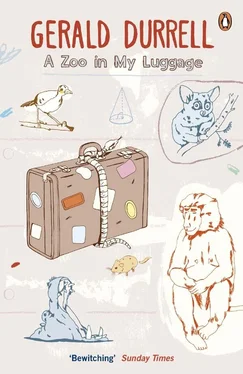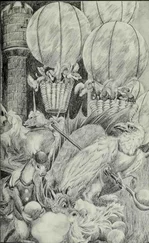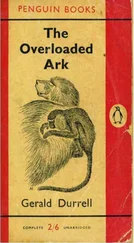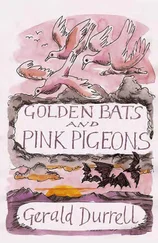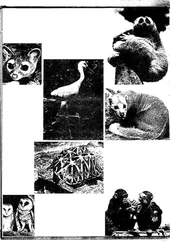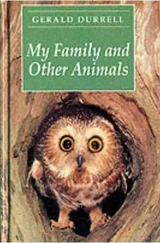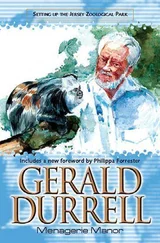Gerald Durrell - A Zoo in My Luggage
Здесь есть возможность читать онлайн «Gerald Durrell - A Zoo in My Luggage» весь текст электронной книги совершенно бесплатно (целиком полную версию без сокращений). В некоторых случаях можно слушать аудио, скачать через торрент в формате fb2 и присутствует краткое содержание. Жанр: Природа и животные, на английском языке. Описание произведения, (предисловие) а так же отзывы посетителей доступны на портале библиотеки ЛибКат.
- Название:A Zoo in My Luggage
- Автор:
- Жанр:
- Год:неизвестен
- ISBN:нет данных
- Рейтинг книги:4 / 5. Голосов: 1
-
Избранное:Добавить в избранное
- Отзывы:
-
Ваша оценка:
- 80
- 1
- 2
- 3
- 4
- 5
A Zoo in My Luggage: краткое содержание, описание и аннотация
Предлагаем к чтению аннотацию, описание, краткое содержание или предисловие (зависит от того, что написал сам автор книги «A Zoo in My Luggage»). Если вы не нашли необходимую информацию о книге — напишите в комментариях, мы постараемся отыскать её.
A Zoo in My Luggage — читать онлайн бесплатно полную книгу (весь текст) целиком
Ниже представлен текст книги, разбитый по страницам. Система сохранения места последней прочитанной страницы, позволяет с удобством читать онлайн бесплатно книгу «A Zoo in My Luggage», без необходимости каждый раз заново искать на чём Вы остановились. Поставьте закладку, и сможете в любой момент перейти на страницу, на которой закончили чтение.
Интервал:
Закладка:
‘They tell me, my friend,’ I said, trying to steer the conversation away from the pros and cons of married life, ‘they tell me tomorrow you go for N’dop. Na so?’
‘Na so,’ said the Fon, ‘I go for two days, for Court. I go come back for morning time tomorrow tomorrow.’
‘Well,’ I said, raising my glass, ‘safe journey, my friend.’
The following morning, clad in splendid yellow and black robes and wearing a curious hat, heavily embroidered, with long, drooping ear flaps, the Fon took his seat in the front of his new Land-Rover. Into the back went the necessities of travel: three bottles of Scotch, his favourite wife and three council members. He waved vigorously to us until the vehicle rounded the corner and was lost from sight.
That evening, having finished the last chores of the day, I went out on to the front verandah for a breath of air. In the great courtyard below I noticed large numbers of the Fon’s children assembling. Curiously I watched them. They grouped them selves in a huge circle in the centre of the compound and, after much discussion and argument, they started to sing and clap their hands rhythmically, accompanied by a seven-year-old who stood in the centre of the circle beating a drum. Standing like this they lifted up their young voices and sang some of the most beautiful and haunting of the Bafut songs. This, I could tell, was not just an ordinary gathering of children; they had assembled there for some definite purpose, but what they were celebrating (unless it was their father’s departure) I could not think. I stood there watching them for a long time and then John, our houseboy, appeared at my elbow in his unnervingly silent way.
‘Dinner ready, sah,’ he said.
‘Thank you, John. Tell me, why all dis picken sing for the Fon’s compound?’
John smiled shyly. ‘Because de Fon done go for N’dop, sah.’
‘Yes, but why they sing?’
‘If the Fon no be here, sah, each night dis picken must for sing inside de Fon’s compound. So dey keep dis his compound warm.’
This, I thought, was a delightful idea. I peered down at the circle of children, singing lustily in the gloomy wastes of the great courtyard, to keep their father’s compound warm.
‘Why they never dance?’ I asked.
‘Dey never get light, sah.’
‘Take them the pressure light from the bedroom. Tell them I send it so that I can help keep the Fon’s compound warm.’
‘Yes, sah,’ said John. He hurried off to fetch the light and presently I saw it cast a golden pool round the circle of children. There was a pause in the singing, while John delivered my message, and then came a series of delighted shrieks and echoing up to me the shrill voices crying, ‘Tank you, Masa, tank you.’
As we sat down to dinner the children were singing like larks, and stamping and weaving their way round the lamp, their shadows long and attenuated, thrown half-way across the courtyard by the softly hissing lamp in their midst.
Mail by Hand
My good friend,
Would you like to come and have a drink with us this evening at eight o’clock?
Your friend,
Gerald Durrell
My good friend,
Expect me at 7.30 p.m. Thanks.
Your good friend,
Fon of Bafut
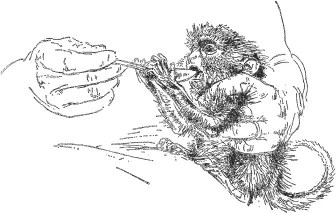
Chapter Five. Film Star Beef
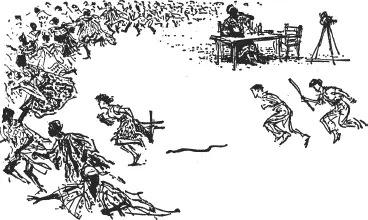
There are several different ways of making an animal film, and probably one of the best methods is to employ a team of cameramen who spend about two years in some tropical part of the world filming the animals in their natural state. Unfortunately this method is expensive, and unless you have the time and the resources of Hollywood behind you it is out of the question.
For someone like myself, with only a limited amount of time and money to spend in a country, the only way to film animals is under controlled conditions. The difficulties of trying to film wild animals in a tropical forest are enough to make even the most ardent photographer grow pale. To begin with you hardly ever see a wild animal and, when you do, it is generally only a momentary glimpse as it scuttles off into the undergrowth. To be in the right spot at the right time with your camera set up, your exposure correct and an animal in front of you in a suitable setting, engaged in some interesting and filmable action, would be almost a miracle. So, the only way round this is to catch your animal first and establish it in captivity. Once it has lost some of its fear of human beings you can begin work. Inside a huge netting ‘room’ you create a scene which is as much like the animal’s natural habitat as possible, and yet which is – photographically speaking – suitable. That is to say, it must not have too many holes in which a shy creature can hide, your undergrowth must not be so thick that you get awkward patches of shade, and so on. Then you introduce your animal to the set, and allow it time to settle down, which may be anything from an hour to a couple of days.
It is essential, of course, to have a good knowledge of the animal’s habits, and to know how it will react under certain circumstances. For example, a hungry pouched rat, if released in an appropriate setting and finding a lavish selection of forest fruits on the ground, will promptly proceed to stuff as many of them into his immense cheek pouches as they will hold, so that in the end he looks as though he is suffering from a particularly virulent attack of mumps. If you don’t want to end up with nothing more exciting than a series of pictures of some creature wandering aimlessly to and fro amid bushes and grass, you must provide the circumstances which will allow it to display some interesting habit or action. However, even when you have reached this stage you still require two other things: patience and luck. An animal – even a tame one – cannot be told what to do like a human actor. Sometimes a creature which has performed a certain action day after day for weeks will, when faced with a camera, develop an acute attack of stage fright, and refuse to perform. When you have spent hours in the hot sun getting everything ready, to be treated to this sort of display of temperament makes you feel positively homicidal.
A prize example of the difficulties of animal photography was, I think, the day we attempted to photograph the water chevrotain. These delightful little antelopes are about the size of a fox-terrier, with a rich chestnut coat handsomely marked with streaks and spots of white. Small and dainty, the water chevrotain is extremely photogenic. There are several interesting points about the chevrotain, one of which is its adaptation to a semi-aquatic life in the wild state. It spends most of its time wading and swimming in streams in the forest and can even swim for considerable distances under water. The second curious thing is that it has a passion for snails and beetles, and such carnivorous habits in an antelope are most unusual. The third notable characteristic is its extraordinary placidity and tameness: I have known a chevrotain, an hour after capture, take food from my hand and allow me to tickle its ears, for all the world as if it had been born in captivity.
Our water chevrotain was no exception; she was ridiculously tame, adored having her head and tummy scratched and would engulf, with every sign of satisfaction, any quantity of snails and beetles you cared to provide. Apart from this she spent her spare time trying to bathe in her water bowl, into which she could just jam – with considerable effort – the extreme rear end of her body.
Читать дальшеИнтервал:
Закладка:
Похожие книги на «A Zoo in My Luggage»
Представляем Вашему вниманию похожие книги на «A Zoo in My Luggage» списком для выбора. Мы отобрали схожую по названию и смыслу литературу в надежде предоставить читателям больше вариантов отыскать новые, интересные, ещё непрочитанные произведения.
Обсуждение, отзывы о книге «A Zoo in My Luggage» и просто собственные мнения читателей. Оставьте ваши комментарии, напишите, что Вы думаете о произведении, его смысле или главных героях. Укажите что конкретно понравилось, а что нет, и почему Вы так считаете.
